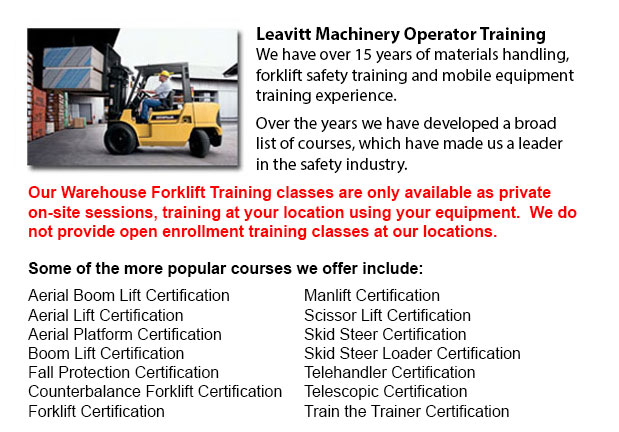
Ontario Warehouse Forklift Safety Training - The business would face claims for liability when injuries and damage are sustained in an accident at the workplace. Warehouses can be a hazardous place to work for its workers, making employee safety a top priority for the business. Warehouse safety training is among the most effective measures to protect personnel, while minimizing expenses connected with accidents and injuries.
Warehouses hold stock that can present a variety of dangers, particularly related to materials handling. Moving stock, either by hand or using powered machines, can cause injuries to employees' hands, fingers, toes and feet. Slipping, tripping and falling are common causes of injury. Heavy stuff could fall off shelves and harm staff. Forklifts and other equipment carry inherent hazards as they manipulate heavily laden pallets. Improper lifting is a common source of back injuries. Even nails, splinters and box cutters can cause harm.
Depending upon the goods and materials which are being handled, the conditions of the warehouse can change from one minute to the next, specially with the machine being utilized and the tasks being done. Because of the different potential hazards in warehouse environment, warehouse operations are regulated by many different standards. There are rules for storage and material handling, for walking and working surfaces, and rules governing the use and selection of PPE (personal protective equipment).
Most of the safety regulations covered by a business will consist of common sense rules. Regulations which warehouse staff should be quite familiar with consist of:
1. Safety is a top priority at all times when working in a warehouse.
2. When work calls for proper PPE, like gloves, safety shoes, eye protection and hard hats, they must be worn.
3. Check for hazards and report them or correct them.
4. Understand warning signals and signs - and follow them.
5. Watch where you're going and concentrate on what you're doing.
6. Pay attention to the work which others are doing nearby, particularly when they are working with forklifts and various hazardous machines.
7. Make sure that stacked materials and products are secured and stable.
To guarantee a safe warehouse, staff should adhere to good housekeeping rules. Essential regulations for housekeeping includes keeping the aisles and floors clear of things like cords and wires. Never perch things insecurely on a surface. When spills happen, clean up immediately. Dispose of garbage in correct containers. Keep fire exits, fire extinguishers and sprinklers accessible. Put box cutters and various sharp tools away immediately after using. Report tripping hazards like for example loose or damaged flooring.
-
Ontario Manlift Certification
Ontario Manlift Certification - The Elevated Platforms and Manlifts Certification course helps to provide the required training on the work practices, safe operating procedures, regulations and rules regarding the everyday activities for the operator... More -
Ontario Crane Training
Ontario Crane Training - Bridge cranes or overhead cranes are actually a type of industrial material handling crane making use of a line and hook mechanism that runs on a horizontal beam running along two widely separated rails. Various overhead cran... More -
Ontario Aerial Lift Train the Trainer
Ontario Aerial Lift Train the Trainer - The Aerial Lifts Train the Trainer Certification Program teaches trainers how to effectively train operators in safe industrial mobile machinery operation. Trainers are given in-depth instruction about aerial l... More -
Ontario Warehouse Forklift Training Classes
Ontario Warehouse Forklift Training Classes - The reason for warehouse training classes are to raise the awareness of common workplace dangers. The trainees will learn essential warehouse safety procedures. An emphasis is placed on paying attention t... More -
Ontario Forklift Training School
Ontario Forklift Training School - Forklift Training School - Industry and federal regulators have established the criteria for forklift safety training based on their current standards and regulations. Those wanting to operate a forklift must finish... More -
Skid Steer Loader Training in Ontario
The engine powered skid-steer loader consists of a rigid and small frame, equipped along with lift arms that could attach to lots of industrial tools and attachments to execute many labor saving jobs. Normally, skid-steer loaders are four-wheel drive... More -
Ontario Crane License
Ontario Crane License - Crane operators ought to be "credentialed", that means they ought to own a crane operator certification or license. Credentialing is considered a mandatory governmental requirement to be able to practice as an operator of a cr... More -
Ontario Forklift Operator Training
Ontario Forklift Operator Training - Forklift training is a prerequisite in North America and is intended to prevent workplace injuries and death. Forklift training offers driver training intended for forklift operators. Training programs teach the s... More

Forklift Certification Ontario
TOLL FREE: 1-888-254-6157
Toronto, Ontario
forkliftcertificationontario.com
Email Us
About Us


